Content
Every good owner of a vehicle has two sets of tires in his arsenal: winter and summer. While one is in use, the other lies in storage in a secluded place, waiting for its season. Therefore, it turns out that each kit is inactive for six months. With this in mind, you should know how to properly store tires without rims and assembled, and what rules to follow to maintain their functionality at a high level.
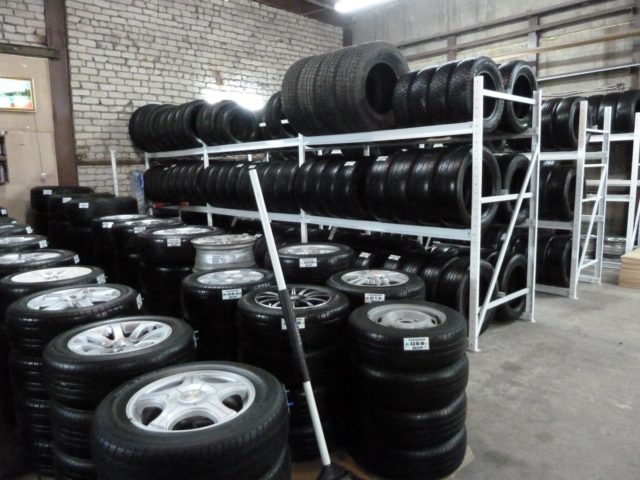
Tire storage features
Before storing wheels, a thorough inspection should be carried out to ensure that they are suitable for future use. Each tire has wear indicators to help you determine how much remains. In addition, it is worth examining them for cracks, bumps, and hernias.
Before storing car tires for seasonal storage, you need to thoroughly clean them of dirt and stones stuck in the tread, as this will accelerate the aging of the rubber and negatively affect its condition.
After completely dry, the wheels must be placed in textile covers made of breathable material, which will ensure air circulation. If they are absent, you can store the tires in plastic bags, but at the same time make small holes for ventilation so that condensation does not accumulate inside. It can corrode the discs and water the rubber.
General rules for storing complete wheels and without discs:
- It is necessary to adhere to a certain temperature regime and avoid sudden changes.
- The tires should be at least 1 m from the heaters.
- Complete wheels and wheels without discs must be stored in different positions to avoid deformation.
- The wheels should be turned and the fulcrum should be changed every two months.
- You can store tires in the fresh air for no more than a month under a canopy or shelter that protects them from external factors.
- It is unacceptable to store wheels on a damp or frozen surface, otherwise deformation cannot be avoided.
- Do not push the tires against sharp objects.
- Do not place heavy objects on top of the wheels.
At what temperature can tires be stored
According to existing standards, wheels can be stored at temperatures from -25 to +35 degrees and humidity at 50-60%. In this case, sharp jumps should not be allowed.
But it should be borne in mind that it is not recommended to store summer tires in the cold, since the lowered temperature negatively affects its quality. In this case, it is worth maintaining the range from +5 to +35 degrees. Therefore, for storing summer rubber in winter, you need to select a heated room so that the conditions in it are as close as possible to the operational ones.
When storing winter tires, a significant drop in temperature is allowed, but before installing the wheels, they must be soaked with positive values. Ignoring this rule can lead to tire deformation and rapid wear.
Despite the fact that winter and summer tires can be stored at elevated temperatures, it should be understood that direct exposure to sunlight has a detrimental effect on rubber. Ultraviolet light provokes the appearance of microcracks as a result of drying out, and it also weakens the strength of the tire and increases the likelihood of tire rupture while driving.
Therefore, for proper storage of wheels, the temperature must be maintained within + 10 ... +25 degrees, excluding direct sunlight.
How to treat tires before storage
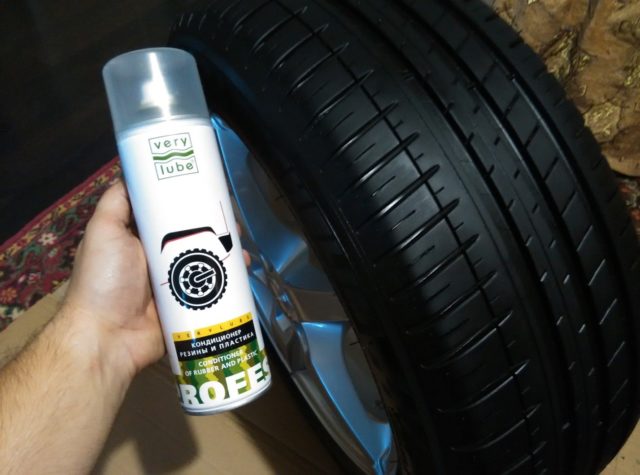
To preserve the quality of rubber, it must be pre-treated with a special aerosol, which is sold in car dealerships. The procedure should be carried out after the tires have been cleaned of dirt and dust, washed and dried.
The product should be applied in 2-3 layers, between which take a break to dry the previous one. At the end of processing, each wheel must be placed in a cover.
Tire storage devices
For the correct storage of wheels on the balcony or in another room, you can use various devices that will help create favorable conditions without much difficulty. For this, strong metal or wooden structures can be used, which can be made by hand.
The main types of devices:
- Racks, shelves... They can be made stationary. For shelving, you will need a rigid cube-shaped frame. In order to eventually make a rack with a size of 2 by 1.5 m, it is necessary to use five frames: 60-80 cm wide, 4 cm thick, 1.5 m long. Prepared shelves must be hung on the wall or initially connected into a common frame. Special attention should be paid to the mountings, since the total weight will be large.
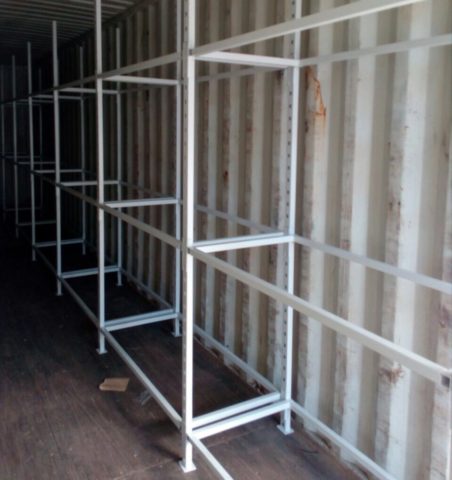 The use of shelving significantly saves space
The use of shelving significantly saves space - Hooks... They should be used for hanging rubber. In this case, the wheel must be hooked onto the disc to avoid contact with the surface.
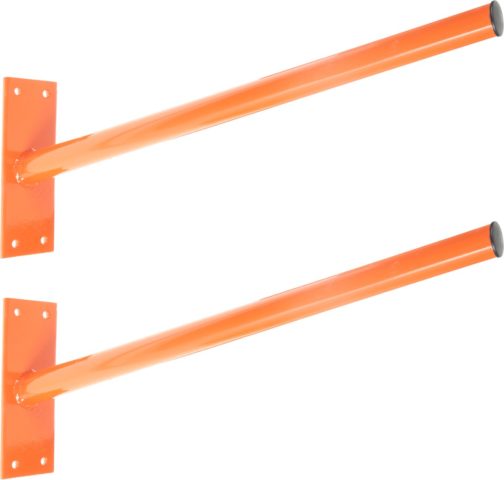 This device means a metal pin that needs to be fixed in the wall.
This device means a metal pin that needs to be fixed in the wall. - Stands... This device is the very rack, but it can be moved.
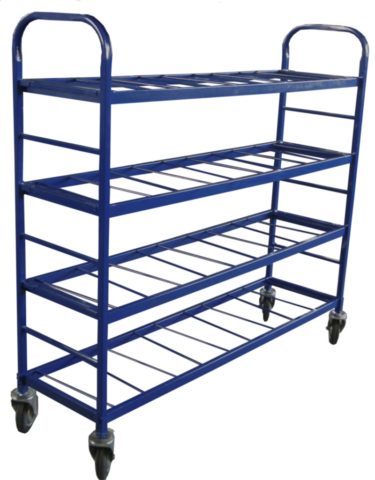 Movable stands allow you to easily move tires if necessary
Movable stands allow you to easily move tires if necessary
All fixtures should be made so that they are comfortable to use.
Where can you store wheels from the car
It is necessary to store wheels on disks and without them in winter and summer, taking into account the basic requirements. For this, you can use different rooms:
- brick garage;
- glazed balcony;
- pantry;
- basement.
When choosing a place, you need to take into account that it must be dry, since an increased level of moisture negatively affects the quality of rubber.
It is not recommended to use sheds, attics, metal garages for storage. This is due to the fact that it is very difficult to maintain optimal conditions in them. And also an unglazed balcony or loggia is not suitable for storage, since the sun, wind, moisture and frost will negatively affect the structure of the rubber. This can damage the wheels in just one season.
It is important that no devices and equipment that emit steam, gas or ozone are used indoors. It should also be borne in mind that contact of rubber with copper and corrosive metals for a long time negatively affects its structure.
If it is not possible to independently ensure the correct storage of assembled wheels and without disks in the garage, you can use the services of tire fitting and auto service centers. For this they have special warehouses, where there are appropriate devices. This service is paid, but guarantees the safety of rubber quality. The price for storing one set varies between 2500-3600 rubles.
When giving tires for storage, you need to carefully study the conditions of their maintenance. All this must be spelled out in the contract, where the responsibility of the car service will also be stipulated in case of loss or damage to wheels. To make sure that all conditions are met, it will not be superfluous to take your own measurements in the room.
In what position to store wheels
When storing wheels, it is important not only to find a place and create conditions, but also to know how to properly position the tires. Many car owners do not attach due importance to this, mistakenly thinking that rubber can lose its quality only during operation. But in the absence of loads, tires can also deform.
You can store wheels with or without discs. This is not of fundamental importance and depends purely on the personal preferences of the owner of the car and the availability of free space in the garage. But at the same time, you should figure out how to properly store tires - lying or standing in either case, and what to do is strictly prohibited.
In what position to store tires without rims
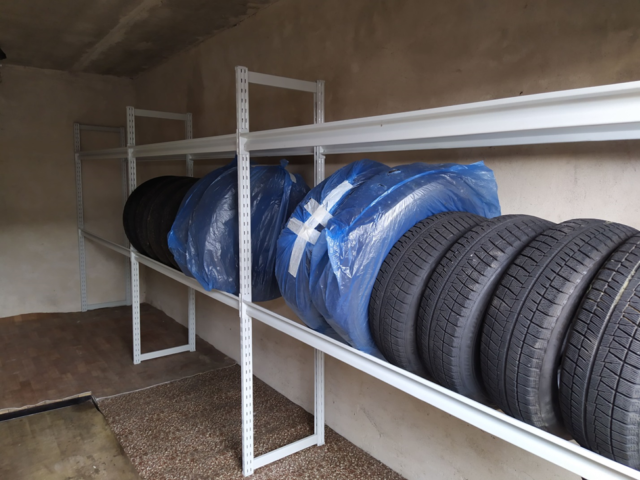
When storing rubber without discs, the usual methods cannot be used, otherwise it will not be possible to avoid deformation of tires of even the most expensive and high-quality brands. The best option is to place the tires vertically with support on a wall, rack or on top of each other. In this case, the rubber should be close, but excluding the possibility of crushing.
Store tires without rims in the garage, subject to the following restrictions:
- do not hang rubber, as this will lead to deformation under its own gravity;
- stacking is not recommended to avoid distortion and uneven tread wear.
In what position to store tires with disks
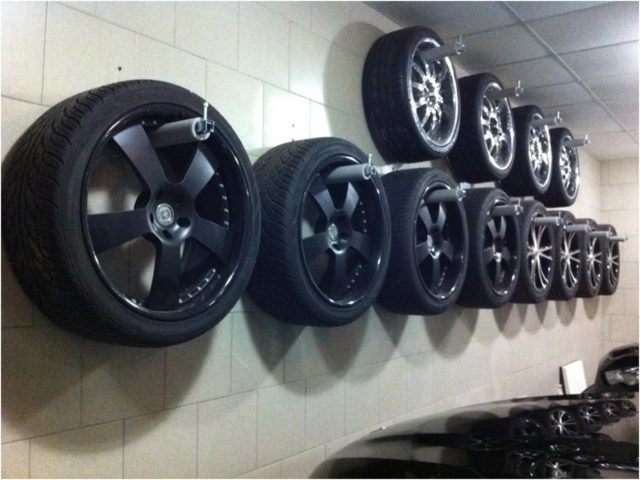
According to the manufacturer's recommendation, it is best to keep the rims inflated. In this case, the possibility of moisture and dust getting on the inner surface of the tire is excluded. Also, there is no need to re-bead the wheels every season, which greatly facilitates the replacement process.
To prevent deformation of the tread under weight, it is necessary to stack the wheels on top of each other in a stack of 2 pcs. At the same time, it is important to turn over and change places of the upper and lower tires every 1-2 months.
Winter and summer tires with disks can be stored in a suspended state. To do this, wrap the hook with a cloth and thread it through the hole in the disc. Tires can be stored in this upright position until the next season, but must be turned over once a month to avoid distortion.
How to store tires correctly
When storing rubber, it is important to comply with the basic requirements. Some of them are absolute, regardless of whether tires are with or without disks. But there are some features that should be considered, based on whether the assembly is rubber or not.
How to store wheels on disks
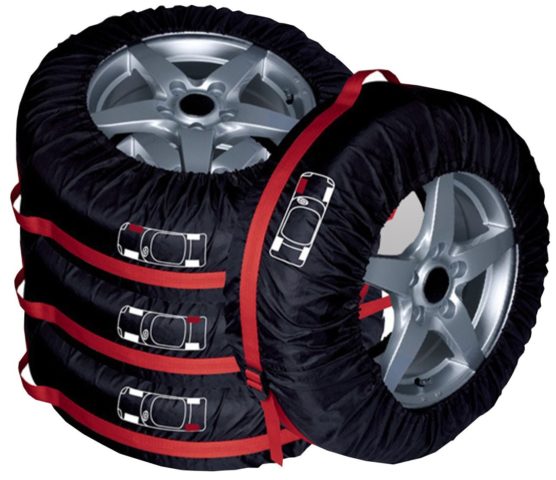
When storing rubber with discs, a number of requirements must be taken into account. This will keep the functionality of the wheels at the desired level and significantly extend the life of the tires.
Storage instructions:
- Choose a dry, heated place, taking into account the permissible temperature and humidity level.
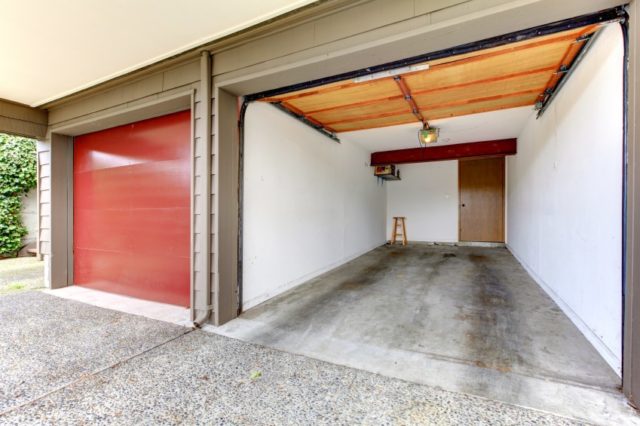 A tire storage room must meet all the necessary requirements
A tire storage room must meet all the necessary requirements - Wash protectors, remove stones.
- Dry the rubber thoroughly, reduce the pressure to 1 atm.
- Treat with a special preservative to slow down the aging process of the material.
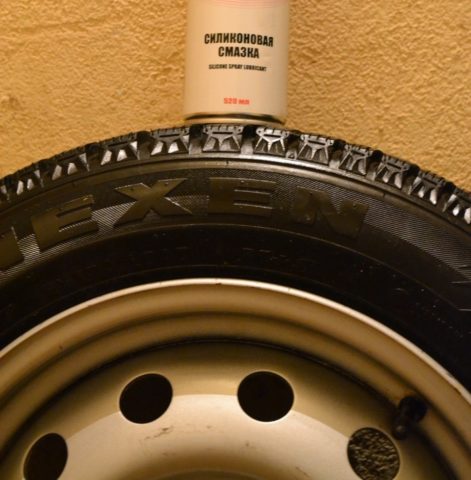 You need to process the wheels only after drying
You need to process the wheels only after drying - Use a white marker to make marks on the rubber indicating the installation location, as well as the side of attachment to the body. This will allow the assembly in the new season without much difficulty.
- Pack in special covers or non-woven fabric.
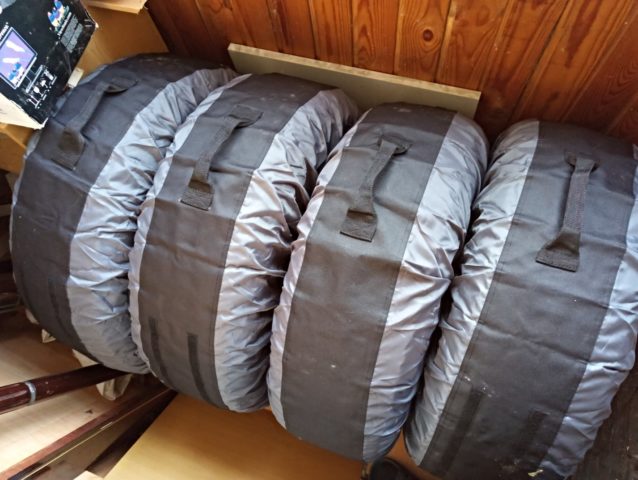 Covers for rubber should allow air to pass through well, this will help to avoid the formation of condensation inside
Covers for rubber should allow air to pass through well, this will help to avoid the formation of condensation inside - Attach the hooks to the wall, wrap them around and thread them through the rim if you plan to hang the tires.
- Place wooden pallets on the floor when storing wheels in stacks of 2.
- Place or hang the wheels, depending on the method chosen.
Castling tires every 1-2 months, changing the fulcrum. This procedure will help keep the rubber undamaged until the next season.
How to store wheels without discs
Tire storage should be carried out taking into account the fact that they are more susceptible to deformation. Therefore, it is important to create conditions that will help to avoid excessive pressure on the rubber.
Storage instructions for tires without rims:
- Prepare the room taking into account the temperature of the content and the humidity of the air.
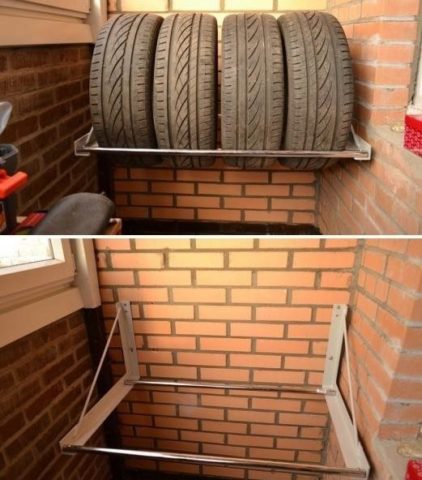 The glazed balcony is also suitable for seasonal storage of tires
The glazed balcony is also suitable for seasonal storage of tires - For storage, choose a hollow shelf, since rubber without discs can only be held in an upright position.
- Wash and dry the protectors, treat with a special agent against premature rubber aging.
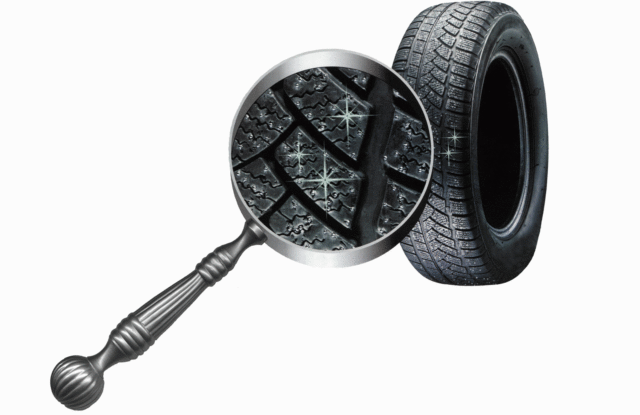 Inspect and wash tires before storage
Inspect and wash tires before storage - Make appropriate notes indicating the location of the tire and the side facing the body.
- Place them in covers or plastic.
 When storing in plastic bags, holes must be made for air circulation
When storing in plastic bags, holes must be made for air circulation - Place tires vertically on shelves or shelves, placing them close to each other.
During long-term storage, it is important to periodically roll the tires and swap them in order to avoid deformation of the beads and maintain symmetry of the shape.
Shelf life of car tires
Any tires, regardless of quality, manufacturer and cost, have a certain shelf life. If all standards for storage and operation of rubber are observed, it does not exceed six years from the date of manufacture.
The duration of operation primarily depends on the quality of the rubber and the special softeners included in its composition. The degree of wear can be determined by visual inspection and by the elasticity of the material. At the end of the shelf life, the tires become hard, cracks appear on them, which makes further operation impossible.
It has been noticed that car tires that are not subjected to long-term storage can last much longer. This is due to the fact that rubber softeners perform their function only under constant loads, and therefore the material does not lose its elasticity. To extend the shelf life of tires, it is recommended to treat the rubber with special agents that create a protective layer on the surface before storing it.
Conclusion
To properly store tires without rims and complete, you need to follow the recommendations. Moreover, all factors are important, since only strict compliance with the requirements will allow to extend the life of the rubber and maintain the quality of the material.
In the absence of the possibility of creating favorable conditions, you should consider the option of storage in a car service.

